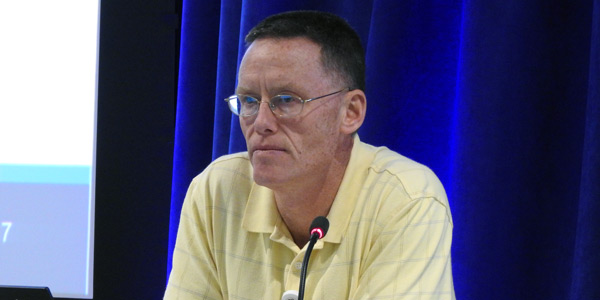VALLEY FORGE, Pa. — PJM’s Michael Herman told members at last week’s Planning Committee meeting that proposed Manual 14B updates to incorporate modeling changes reflecting the cancellation of the Con Ed-PSEG “wheel” would include reductions in emergency transmission limits.
The capacity emergency transfer limits (CETLs) would be reduced in certain load deliverability areas (LDAs), including by 500 MW in EMAAC, 1,100 MW in MAAC, 1,527 MW in PSEG and 1,309 in PS North.
At PSEG, that would put the CETL at just 574 MW above the capacity emergency transfer objective (CETO), the threshold for necessary transfer capacity to ensure reliability in an emergency. In PS North, the difference between CETL and CETO would be just 335 MW.
The modeling adjustments come in response to Consolidated Edison’s decision to end a decades-long agreement with PJM to route 1,000 MW from upstate New York to New York City through Public Service Electric and Gas’ northern New Jersey territory. The change necessitated reanalysis of regional power flows, which eventually identified that continuing an “operational base flow” of 400 MW would be the most reliable solution. (See Analysis Recommends Continuing Reduced Con Ed-PSEG ‘Wheel’ for Grid Stability.)
In the updated CETL calculations, PJM removed any non-firm energy transfers. However, it kept them in its updated capacity import limit calculations. Stakeholders questioned why non-firm was removed from the CETL.
“If it’s a non-firm product, we just can’t depend on it during these critical times,” PJM’s Mark Sims said. “There could be a time when our system is stressed, the neighboring system is stressed, and then to depend on non-firm energy to support your system … just doesn’t make sense.”
The revisions were approved by acclamation with one objection and 14 abstentions.
PJM has scheduled a webcast on Aug. 30 from 1-3 p.m. to address questions about the CETL procedural changes.
Resilience Planning to Recognize Outage Propagation Potential
Sometimes, resilience means knowing when to give up.
In analyzing its planning criteria, PJM will be considering what is likely to happen downstream when a piece of equipment fails. Sometimes, this will mean the equipment simply collapses at that point. But it could also open a pathway for cascading failures further throughout the system and a larger collapse. (See “Resilience to Become Planning Driver,” PJM PC/TEAC Briefs: July 13, 2017.)
“If you had an existing station where you improved the strength of it such that during an event, where normally it would be lost very quickly and cleanly, it’s now hanging on,” Sims said.
As a result, the grid operator could face a scenario “where the system collapsed instead of being bounded because you actually have a stronger part of the system which allows the event to propagate further and in the end the result is worse,” he said.
To prepare for such a contingency, PJM is developing appropriate metrics and criteria for factoring resilience into planning.
“These are not events that happen often. I can’t pull data on voltage collapses,” Sims said. “We have to do our best to make some valid assumptions.”
Stakeholders have previously asked how PJM plans to address the subjectivity of the topic.
“To PJM, megawatts would just be load, but to others, megawatts are customers,” said John Farber with the Delaware Public Service Commission. He asked if PJM plans on considering the amount of load that would be impacted by a piece of equipment failing.
“I don’t know if you’re suggesting that some load is perhaps more critical than others, [but] I think many people would generally agree with that,” PJM’s Paul McGlynn said.
“I salute your eagerness to swim with the alligators,” Farber replied.
Market Efficiency Analysis Ongoing
Staff have completed analysis of market efficiency projects in the Reliability Pricing Model and are nearly finished examining interregional projects, Sims told members at last week’s Transmission Expansion Advisory Committee.
The RTO is currently reviewing projects from PPL’s zone.
The analysis identified six projects to be recommended for approval by the Board of Managers, including four in Commonwealth Edison’s LDA and one in Duke Energy Ohio/Kentucky. Two of the ComEd projects were proposed by American Electric Power.
Six other proposals — two from AEP and Exelon, one from Transource Energy and three from Northeast Transmission Development — were not recommended. PJM is expecting to seek approval on recommended projects at the board’s October meeting.
Reliability Analysis for 2022 Finds 190 Violations
PJM’s reliability analysis of the Regional Transmission Expansion Plan for 2022 conditions found violations at 190 flowgates.
The majority (115) were generation delivery issues, with most of those (50) being on 138-kV lines on the western side of the RTO’s footprint. Overall, the 138-kV system had the most issues, with 77 violations identified.
The runner-up was the 345-kV system, with 46 violations identified. That system also had 35 of the 37 overall total high-voltage violations. All 35 were in the MAAC region.
Of the total 190 flowgates identified with violations, 41 will be included in the 2017 RTEP proposal window: 33 in the West region, five in the South region and three in MAAC. Generation delivery issues account for 35 of the available projects and six are N-1 thermal violations.
The remaining 149 flowgates were excluded because they were either “immediate need” projects or under 200 kV, which are expected to be addressed by the incumbent transmission owner.
— Rory D. Sweeney





